It’s not easy to walk around Manchester and picture the place as it might have looked in 1745 – but it’s not impossible either. And I’ve done this Manchester Jacobites walk now in a couple of different ways. The simple way is to stand in three different locations – the Victoria pedestrian bridge, the side of Marks & Spencer on the corner of Exchange Street, and in St Ann’s Square – or to use those three points as the start of short, circular and interlinked walks.
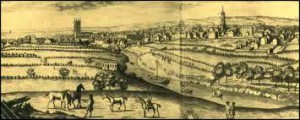
Victoria Bridge
The current Victoria Bridge (1839), and its new pedestrian neighbour, sit roughly on the site of the old Salford Bridge (which Bonnie Prince Charlie and his Scots army crossed on 29th November 1745), a medieval structure with, on the Salford side, an old chapel that served as a dank dungeon. The town had actually been captured on the previous day (28th November), famously without a fight, by a certain Sergeant Dickson, his companion – Long Preston Peggy – and a drummer.
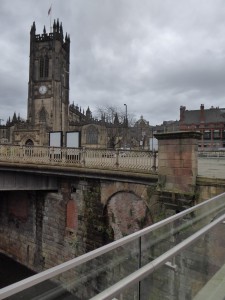
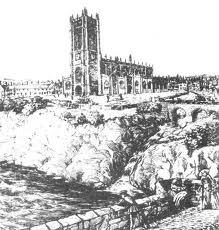
But the view from the bridge is dominated, as it was in 1745, by the Collegiate Church of St Mary, St Denys and St George, now Manchester’s Cathedral. The present structure dates from the 13th Century and was substantially re-built in the 1800s. In 1745, the congregation was dominated by High Church Tories and Jacobite sympathisers, and its chaplains enthusiastically greeted Bonnie Prince Charlie when he arrived in the town. The Whig Loyalists, on the other hand, worshipped at St Ann’s – but more about that later.
If we move off the bridge to start the first of the three circular walks, it’s easy to find the remains of the Hanging Bridge, just across the road. Back in the Middle Ages, this bridge crossed a stream, known as the Hanging Ditch, but by 1745, this had been filled with rubbish and rubble, and houses built on top. The bridge was only re-discovered during Victorian building work.
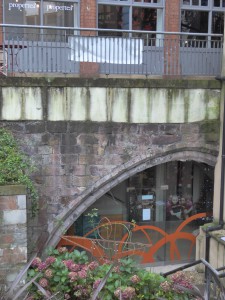
From the Hanging Bridge, we go past the front of the Cathedral and then, with the river on our left, remember that we’d now be walking in front of the House of Correction.
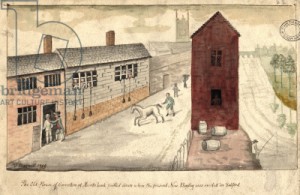
We turn right into Hunts Bank, bearing in mind that this is roughly where the Irk would have met the Irwell and flowed along Walker Croft, down to our right and below Chetham’s. We follow Hunts Bank around past the front of Victoria Station, then turn right onto Long Millgate to reach the front entrance of Chetham’s Library. The current Chetham’s School of Music is built on the site of an old fortified Norman mansion house and, possibly, the site of much earlier Saxon and/or Celtic fortresses. There was a religious college here in the 15th Century and, in the 1650s, philanthropist Humphrey Chetham bequeathed enough money in his will for the construction of a hospital, library and charity school. By 1745 it had become a charitable “blue coat” school for around 40 boys. The adjoining library amassed an enormous collection, over 100,000 books, most of them printed before 1851, and the interior is exquisite.
If we leave Chetham’s and keep the National Footbal Museum on our left, we can walk up to Corporation Street (which didn’t exist in 1745). On our right is the collection of buildings called The Triangle and, somewhere in the centre of that block, the old street called Hanging Ditch would have run up from where we saw the remains of the Hanging Bridge, and here there were some fine houses, including the one in which John Byrom and his family now lived. On Corporation Street we head along to the corner of Marks & Spencer.
Marks & Spencer
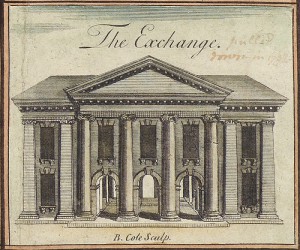
If we’ve come straight from the bridge, we need to walk up St Mary’s Gate and stop near the small roundabout at the end of Exchange Street. Alternatively, we may have completed the first circular walk and, coming along Corporation Street, turned down the side of Marks & Spencer to the same mini-roundabout. Either way, we have to try and picture that, roughly where the Zara store now stands, in 1745, there was an impressive Exchange – a two-storey stone building where market activities took place between the colonnaded ground floor columns while, in the halls above, business and trading activities took place, as well as concerts and meetings of the Court Leet (Town Council).
The pedestrianised bit of Exchange Street that runs between Zara and Marks & Spencer follows the old Market Place. The town cross once stood here, as well as a water conduit for drawing fresh water, and about 100 yards along on the left, is the original location of the Old Wellington Inn.
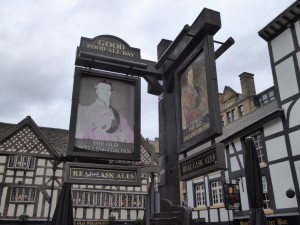
This is the building in which famous writer John Byrom had been born although, by 1745, it housed a draper’s shop and rented rooms, and had been extended to include John Shaw’s Punch House – later Sinclair’s Oyster Bar. In The Jacobites’ Apprentice, one of my main characters, Aran Owen, lives in a room on the third floor. Byrom was a Jacobite supporter, and so too was his daughter, Beppy, who kept a detailed diary of those heady days. But, by 1745, they were living in their much grander house on Hanging Ditch.
Meanwhile, the house in which Byrom had been born stood at the corner of the old Shambles Square, a cluster of buildings in the centre but the butchers’ stalls – giving the Shambles its name – around the outside. In 1745, there were two further inns here – the Bull’s Head, where the Tories and Jacobite supporters supped while, across the way, the Whigs and Hanoverian Loyalists gathered at the Angel. The Bull’s Head also served as the town’s post office and, on 29th and 30th November 1745, it became the recruiting centre at which 300 Manchester men, under the command of Francis Townley, enlisted to form their own regiment within Bonnie Prince Charlie’s army. But when he was forced to retreat back to Scotland, just a few weeks later, the Manchester Regiment was left behind at Carlisle, as a rearguard. There they were captured, imprisoned and their leaders later executed in London.
The whole area around Shambles Square was rebuilt after it was devastated by an IRA bomb in 1996, with the Old Wellington carefully moved to its current location.
The second short additional walk takes us back up past Marks & Spencer and across into Market Street.
Walking up Market Street, it’s worth trying to imagine this as the much narrower, and somewhat sinuous thoroughfare, known as Market Street Lane in1745.
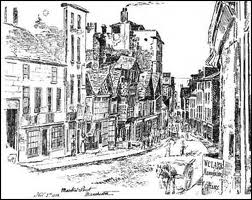
But some fine town houses were being built here too and, just past the entrance to the Arndale Centre, stood the house of prominent merchant John Dickenson, where Bonnie Prince Charlie stayed on his nights in Manchester.
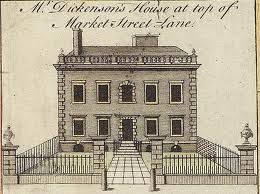
It later became the Palace Inn. Immediately opposite was the equally grand mansion of another merchant, James Marsden, where the Duke of Athole was billeted. A short way further up on the left, some steps led to the lane where the town’s cockpit was located.
Then we head down to Exchange Street again.
St Ann’s Square
Back at Exchange Street, but before going on, it’s worth remembering that, in 1745, the entrance to St Ann’s Square was then through an alley here, beneath one of Manchester’s early coffee houses.
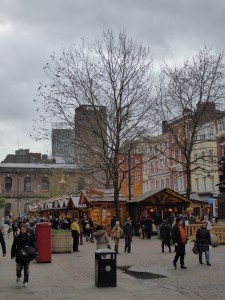
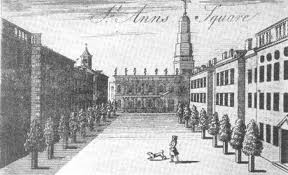
By 1702, when Queen Anne had come to the throne, there was already strong Jacobite sentiment in the town – those who wanted to see the pro-Catholic and exiled Stuart dynasty back in power. And the Collegiate Church had become a hot-bed for Jacobite sermons. As a result, local notable, Lady Ann Bland, determined to have a new, rival and loyalist church built on the open ground then known as Acresfield – the site of Manchester’s Annual Fair. The church was named St Ann’s and Acresfield eventually became St Ann’s Square. This is one of the sites most easy to imagine in its 1745 appearance though, at the time, it could only be accessed by narrow and dingy alleys at its corners.
It’s said that those Manchester folk who wanted to “hedge their bets” between the town’s factions chose to worship at St Ann’s in the morning and at the Collegiate Church in the evening.
All the same, the second rector of St Ann’s, the Reverend Joseph Hoole, had only died shortly before the Jacobites’ arrival in the town. He was known as a fanatical opponent of the Jacobites and his widow apparently feared that they might disrupt his funeral. As it transpired, the funeral was in progress, in the small burial ground then at the eastern end of the church, when Bonnie Prince Charlie’s Highlanders came pouring into the square. But, contrary to the Widow Hoole’s fears, the Scots officers stood in silent prayer around the cemetery.
Another very short walk takes us down to the church itself (there was a spire on top of the tower in 1745), which is still pretty much in its original condition. But around the outside are some of the grave stones from the burial ground. One of the most prominent, at the north-east corner, is the raised ‘chest tomb’ of Thomas Deacon, the pro-Jacobite and non-juror bishop of the Orthodox British Church. The inscription describes him as “the greatest of sinners” but Deacon apparently wrote this himself before he died, and still full of remorse, for each of his three sons had joined Bonnie Prince Charlie’s regiments – and paid the price for it after Carlisle, one executed, one died of fever, and one transported. A plaque on the wall here also tells the story of Joseph Hoole’s funeral.
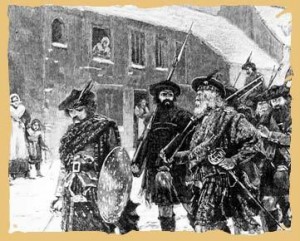
Well, that concludes the route, though it’s worth remembering that the Jacobite army returned to Manchester on 9th December 1745, only just over a week after their first visit, though now in retreat towards Scotland. But their reception was very different from that which they’d enjoyed on their way south. No longer the conquering heroes, their fickle supporters kept to their houses, while their opponents, made bold by the changed circumstances, turned out to jeer them and even risk the occasional potshot.
If you’ve got a group interested in all this, please feel free to use any of the blog page as a guide. But nice to just let me know if you’re doing the walk – and who knows, I might just join you!
Are still doing these tours?
Very much enjoyed you’re book.
Hi Christopher. Only just spotted this comment so apologies for the delay in replying. I do the tours pretty much “on demand” whenever there are a few people keen to do them. I’ll keep you posted if you like or, alternatively, if you know folk who’d like to do one, let me know. Glad you enjoyed the book too.
Great reading. Thank you
Thanks Beverly. Glad you liked it.
Hi David, I would be very interested in participating in this tour next year. I am one of the organizers of several commemoration events in Scotland, England, France and Italy on all things associated with the Jacobite cause, in fact, we will be back in Carlisle in November to follow up on the Execution site of the Jacobite there. The idea is to have a memorial erected near the site of the former gallows before it is lost forever with the construction of a new housing scheme! This of course is where Thomas Coppoch appointed Bishop by Charles Edward Stuart at Manchester was buried in an unmarked grave, while others were buried in the churchyard in the city. We can arrange a date later, as I will speak to all those who might be interested in coming along (some are on shifts) at a date and time convenient to all including yourself. Regards, Kenny Borthwick.
Hi Kenny. Great to hear from you and wonderful that you’re organising the events. It’s now four or five years since anybody contacted me about the Manchester tour but yes, please get in touch if you decide to press ahead. As it happens I’m now in Spain for big chunks of each year but if I’m around it would be nice to do this again. Strangely, after many years of writing about other stuff (Spanish Civil War thrillers etc) I’m now back with Jacobites again, though in 1715 this time, the third part of my Yale Trilogy, with some scenes set during the Battle of Preston. The walking tours, by the way, have all been highly informal and usually good fun – depending on the weather. But if you want to chat some more, maybe e-mail me direct on davemccall@davidebsworth.org. Best regards. Dave
Hi David, it’s been a few years since I contacted you with regards to giving some of us a tour.
Of course, Covid got in the way but as we are now through that period it would be good to resurrect this walking tour with you.
Are you still involved, if so, I will see who would be willing to attend later in the year. Thx, Kenny Borthwick
Hi Kenny. Serious apologies but this message has only just appeared, for some weird reason. I haven’t done the Manchester Jacobites tour for a long time, but let me know if anybody might be interested and I could certainly think about doing another. Obviously, I’m now bogged down with lots of other “new” stuff but the Jacobite involvement in the Manchester, Preston etc is still always interesting.
Enjoyed this – looking forward to a visit some time.
Worth noting though that Dr Deacon wasn’t the Anglican Bishop of Manchester – he was a nonjuror with a small congregation (less than 100) and his church was called the Orthodox British Church. He lived in Fennel Street and three of his sons died as a result of the ’45 – serving in the Manchester Regiment. The nonjurors survived until the early C19th. Their last Bishop died as late as 1818. Their former chapel is now covered by the Arndale Centre….
Hey Steven. Thanks for the correction – I’ll amend immediately. To be honest, some of these early posts are so old that I really should go through and fact-check all of them. Deacon’s portrayed more accurately in the novel but not here in this post (written while the novel was still being written, if I remember correctly). Hope you’re OK though and best regards. Dave
Very interesting history of the Jacobites in Manchester.
I remember the Old Wellington pub before it was moved. I’d gone with a friend to Manchester and he knew it, up some long low concrete steps to the shops and pub.
I’ve looked at St Mary’s Church and gravestones and the old Hanging Bridge but not knowing what it was. Chetham’s School of Music is an impressive building as is the Ryland’s Library of which I took a tour inside.
I visited Brampton near Carlisle and the site of the Hanging Tree, now marked with a memorial, where three Jacobite soldiers were hung along with three from the Manchester Regiment.
Thanks Bill. Only just seen this – so apologies. But thanks for the comments. Some fascinating and little-known stuff about the Jacobites. Glad you liked the piece.
How much do you charge for a Jacobite walk?
Hi Nigel. Just sent you an email reply.